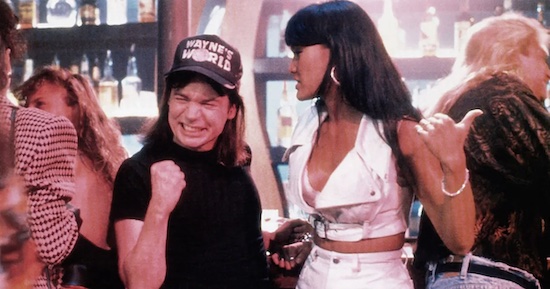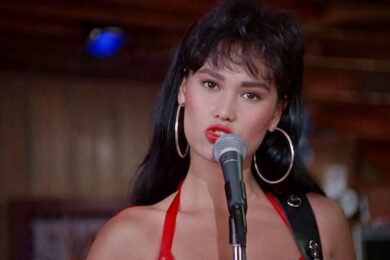Thirty years ago, Penelope Spheeris directed a comedy that would break the genre’s mould thanks to one woman: Cassandra Wong. The film is ostensibly about best friends Wayne and Garth (Mike Myers and Dana Carvey), who broadcast their show Wayne’s World from Wayne’s parents’ basement – the easy-going pair love nothing more than hanging out and listening to rock music. But one rock star, however, would steal Wayne’s heart. Yet Tia Carrere’s Cassandra is far from a bland love interest, more than a prize to be chased – an empowered hero in her own right.
Wayne’s World is undoubtedly a story told from a male perspective. The central friendship, humour, and characters such as Lara Flynn Boyle’s Stacy (a troubled ex-girlfriend nicknamed “Psycho Hose Beast”) all point to a world created by men for men of a similar age. But Cassandra doesn’t exist to serve her male co-star, or be rescued by him.
We first meet her at metal club The Gasworks, with Wayne staring up in awe as he watches Cassandra, front and centre on stage, performing a powerful cover of Jimi Hendrix’s ‘Fire’. Immediately afterwards, she becomes collateral damage in a fight between two men. This might usually be the time when Wayne would come to the rescue, but Cassandra doesn’t need any help. She takes out both men in a slow-motion fight scene, while Wayne looks on in admiration, declaring “I love this woman!” to the viewer. It’s a sentiment repeated again in a music shop when Wayne shows Cassandra his dream guitar, and she knows just as much about it as he does. Rather than being threatened, Cassandra’s confidence only attracts him more.
Rather than a hollow object of affection, Cassandra becomes her own person. She speaks both Cantonese and English, the latter she learned in college (and, she adds, from Police Academy movies). She is on her own journey with her band, the hard rock four-piece Crucial Taunt. Cassandra looks to break through musically after meeting Benjamin (Rob Lowe), a sleazy executive looking to acquire Wayne’s World.
Here, we meet not one but two antagonists – Benjamin, and Wayne’s own insecurity. Benjamin seems to have ulterior motives in helping Cassandra’s career, but the film is careful to emphasise she is progressing thanks to her talent. This is said outright when she breaks up with Wayne. “Maybe he thinks I’ve got some talent,” she replies when Wayne questions the attention she’s getting from Benjamin. “Maybe he’s pokin’ ya,” Wayne retorts, to which an astonished Cassandra says, “You think that’s the only way I can get a gig?” It’s clear Wayne is in the wrong, further shown by a disastrous attempt to prove her video shoot is fake through accusing Benjamin of not booking the rest of her band (he has) and there being no film in the cameras (there is). Cassandra’s talent, and authenticity, is never in doubt – Wayne is the one making the mistake.

Cassandra, a talented, charismatic, and independent female character, stood out from her contemporaries in the slacker comedy genre in the ‘90s. Films like Kevin Smith’s Clerks and Dazed and Confused in 1993 featured women who were talked about more than they spoke for themselves, while fellow rocking airheads Bill and Ted’s love interests were literally mediaeval damsels in distress. Cassandra remains a refreshing burst of positive femininity, in the sea of comedy masculinity that surrounded her at the time.
It was the combination of talent on both sides of the camera that ensured this vision was realised. In the film’s making-of documentary, Extreme Close-Up, Carrere says it was in Myers’ script that Cassandra had to be Asian, otherwise she believes the character would have been “some buxom, blonde haired, blue-eyed girl that is often seen as ‘The Girl Next Door.’” Spheeris also emphasised the need for her to have an “independent air”. This could have only been fully realised with a female director of her experience, having made The Decline of Western Civilisation documentaries that examined the egos and frailties of the ‘80s hair metal scene.
Cassandra isn’t the only example of Myers’ enlightened approach to female characters. The plot of 1997’s Austin Powers: International Man of Mystery sees Austin Powers, a man literally frozen in time, with outdated attitudes towards the treatment of women, paired with Vanessa Kensington (Elizabeth Hurley), who demands respect from Powers in both her words and actions after many unwanted advances. Sadly, this ambition disappeared from Myers’ writing in the franchise’s sequels, as female co-stars such as Heather Graham and Beyoncé Knowles became interchangeable. Also, Myers reportedly had issues with Spheeris on Wayne’s World, stemming from a disagreement over the final cut of the movie that led to Spheeris not being asked back for the sequel in 1994, being replaced by Stephen Surjik. “Because of that (the disagreement), he decided that I couldn’t direct it,” Spheeris said in 2017. “He had the power with the studio, because without Mike, you don’t have a movie.”
This follow-up didn’t share the same joyful energy of its predecessor, content with pop culture spoofs of films like Jurassic Park, and problematic characters like “The Weird Naked Indian”, a Native American character who appears in one of Wayne’s dreams. Cassandra’s role is also diminished, becoming a prize to be fought over as she allows her overbearing father (James Hong) to marry her off to the film’s villain, music producer Bobby (Christopher Walken).

But she was present in the sequel, which isn’t always a given for female characters (just ask Hurley in the second Austin Powers film, or Morena Baccarin’s character Vanessa in Deadpool 2, both of whom are killed within the first few minutes of their respective films). Her importance is a credit to Carrere’s breakthrough performance. A charismatic presence, she was a woman of colour whose background was celebrated rather than stereotyped. Carrere’s acting talent was matched by her singing ability (or, in Wayne’s words, “she can really wail”). Her musical prowess in this film kicked off a music career that saw her win two Grammys for her Hawaiian music albums ‘Ikena’ in 2008 and ‘Huana Ke Aloha’ in 2012; while she also went on to play a ruthless villain in action movie True Lies, a professor-cum-treasure hunter in cult TV show Relic Hunter, and an older sister/guardian in Disney’s Lilo and Stitch. Her comedic timing and powerful screen presence as the “Baberaham Lincoln” of Wayne’s World was the launchpad for a long, convention-defying career which saw her take on a diverse array of projects, from comedies like Curb Your Enthusiasm to reality TV such as Dancing With The Stars.
Comedies can age poorly over time – hits from around the same time such as Ace Ventura: Pet Detective will draw a wince from modern audiences due to outdated portrayals of race, gender, and sexuality. However, Cassandra is part of the reason why Wayne’s World remains a delight all these years later. Its comedy is derived from the youthful optimism and enthusiasm of its leads, rather than finding targets to laugh at. The introduction of Cassandra’s powerhouse is still one of the film’s highlights, reflecting the overall good times of the story, while also offering a landmark female performance.



